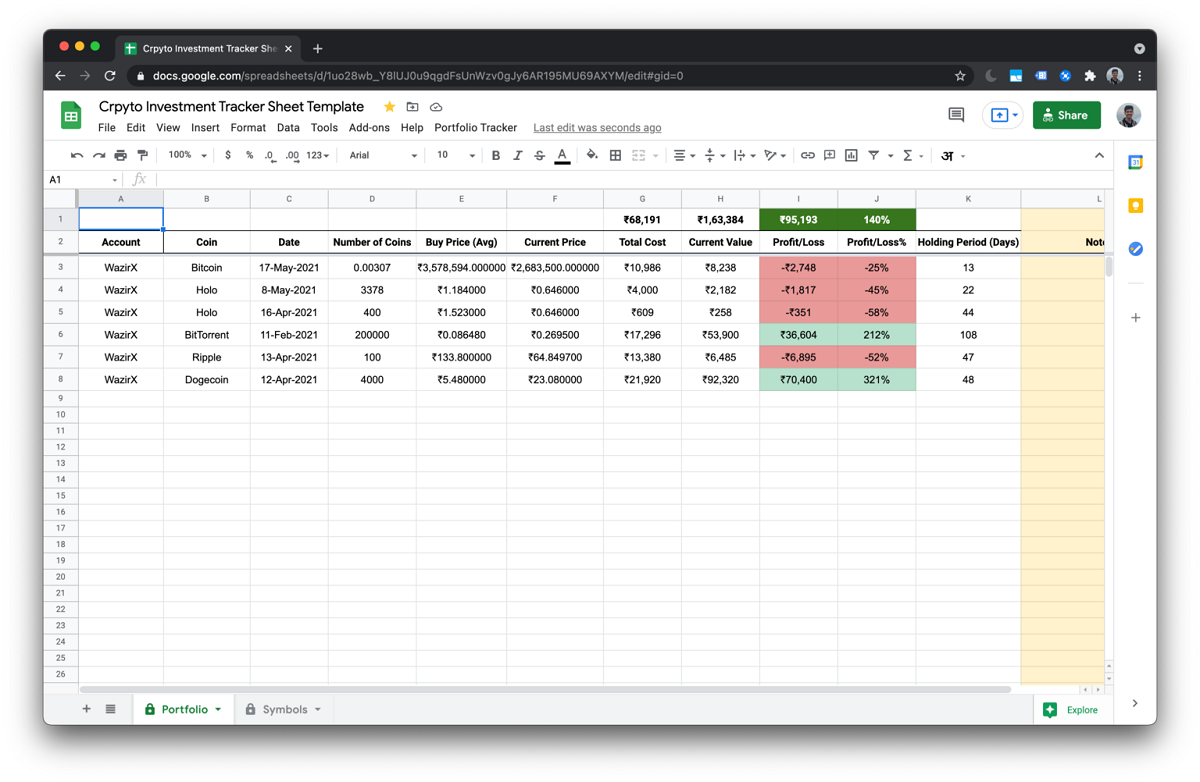Introduction
Welcome to the exciting world of cryptocurrency! As digital currencies continue to gain popularity, it is essential for cryptocurrency enthusiasts and investors to stay updated on the latest trends and developments in the market. Tracking cryptocurrency is a crucial aspect of successfully navigating this dynamic industry. Whether you are a seasoned investor, a crypto trader, or simply someone curious about the possibilities, understanding how to effectively track cryptocurrency can help you make informed decisions and maximize your investment potential.
Cryptocurrency tracking involves monitoring and managing various aspects of digital currencies, including prices, portfolios, news, and trends. By actively tracking your cryptocurrency holdings, you can gain insights into the market, identify opportunities, and mitigate risks. Fortunately, with the advancement of technology, tracking cryptocurrency has become more accessible and efficient than ever before through the use of specialized tools and platforms.
In this comprehensive guide, we will explore the benefits of tracking cryptocurrency and the different methods you can employ to stay informed. We will discuss manual tracking methods, as well as the use of cryptocurrency portfolio trackers, price tracking tools, and strategies for monitoring news and events. Additionally, we will delve into the importance of analyzing cryptocurrency trends and offer tips for ensuring the security of your tracking activities.
Whether you are an experienced crypto enthusiast or just starting your journey into the world of digital currencies, this guide will equip you with the knowledge and tools necessary to stay ahead of the curve. So, let’s dive in and discover how to effectively track cryptocurrency to elevate your investment game and seize the opportunities that lie ahead.
Benefits of Tracking Cryptocurrency
Tracking cryptocurrency offers numerous advantages for investors and enthusiasts alike. By staying informed about the latest trends and developments in the market, you can leverage these benefits to optimize your investment strategy and make well-informed decisions. Here are some key benefits of tracking cryptocurrency:
- Real-time monitoring: Tracking cryptocurrency allows you to stay updated with real-time price movements and market trends. This enables you to seize profitable opportunities and make timely decisions regarding your investments.
- Portfolio management: Cryptocurrency tracking tools and platforms provide you with the ability to manage and track your portfolio effortlessly. You can monitor the performance of your holdings, track profit and loss, and make adjustments as needed.
- Identifying trends: By tracking cryptocurrency, you can identify emerging trends and patterns in the market. This information can help you anticipate future price movements and adjust your investment strategy accordingly.
- Managing risk: Effective tracking allows you to assess and manage risk more efficiently. By constantly monitoring the market, you can identify potential risks and take necessary measures to protect your investments.
- Seizing opportunities: Cryptocurrency markets are highly volatile, presenting numerous opportunities for profit. By tracking the market, you can spot potential investment opportunities, such as undervalued assets or upcoming projects with promising potential.
- Market insights: Tracking cryptocurrency provides you with valuable insights into the overall market sentiment and investor behavior. Understanding market trends and sentiments can help you make more informed investment decisions.
- Staying ahead of the curve: The cryptocurrency landscape is ever-evolving, with new projects and technologies emerging constantly. By tracking cryptocurrency, you can stay informed about the latest developments, regulations, and market news, ensuring that you stay ahead of the curve.
- Educational opportunities: Tracking cryptocurrency allows you to continually learn about different aspects of the industry. By researching and analyzing market trends, you can expand your knowledge and deepen your understanding of cryptocurrencies and blockchain technology.
Overall, tracking cryptocurrency is an essential practice for anyone involved in the digital currency market. Whether you are a long-term investor or a short-term trader, the benefits of staying informed and keeping a close eye on the market cannot be overstated. It provides you with a competitive advantage, enabling you to make accurate predictions, mitigate risks, and seize the exciting opportunities that arise in this rapidly evolving industry.
Choosing a Tracking Method
When it comes to tracking cryptocurrency, there are various methods and tools available to suit different needs and preferences. Choosing the right tracking method is crucial to ensure that you can effectively monitor your investments and stay informed about market trends. Here are some common tracking methods to consider:
- Manual Tracking: This method involves manually recording and updating your cryptocurrency holdings and transactions. While it may require more effort and time, manual tracking provides full control and customization over your tracking process. You can use spreadsheets or dedicated journals to keep track of your assets and monitor their performance.
- Cryptocurrency Portfolio Trackers: Portfolio tracking platforms offer a convenient and automated way to monitor your cryptocurrency investments. These tools sync with your exchange accounts and wallets, providing a comprehensive overview of your portfolio’s value, performance, and asset allocation. They often come with features such as price alerts, historical data, and performance analysis, making it easier to track and manage your investments.
- Price Tracking Tools: If your primary focus is monitoring cryptocurrency prices, price tracking tools can be beneficial. These tools provide real-time price updates for various cryptocurrencies, allowing you to track price movements, set price alerts, and analyze historical price data. Some popular price tracking websites and applications include CoinMarketCap, CoinGecko, and TradingView.
- News Aggregators and Social Media: Staying informed about the latest news and developments in the cryptocurrency industry is crucial for effective tracking. News aggregators and social media platforms dedicated to cryptocurrencies, such as CoinDesk and Twitter, can provide valuable insights. By following reputable sources and influential figures, you can stay updated with market news, regulatory changes, and project updates.
- Technical Analysis Tools: For those interested in analyzing cryptocurrency trends and patterns, technical analysis tools can be valuable. These tools use various indicators and charting techniques to identify potential price movements and support investment decisions. Popular technical analysis platforms include TradingView and CryptoCompare.
When choosing a tracking method, consider your specific needs, preferences, and level of involvement in the cryptocurrency market. If you are a casual investor with a small portfolio, manual tracking or portfolio tracking apps may be sufficient. However, if you have a more extensive portfolio or engage in active trading, more advanced tools like price trackers and technical analysis platforms may be beneficial.
It is worth experimenting with different tracking methods to find what works best for you. You can also combine multiple methods to create a comprehensive tracking approach. The key is to choose a method that allows you to monitor your investments effectively and stay informed about market trends, ultimately helping you make better-informed decisions in the world of cryptocurrency.
Manual Tracking
For cryptocurrency enthusiasts who prefer a more hands-on approach, manual tracking is an effective method to monitor their investments. Manual tracking involves recording and updating your cryptocurrency holdings and transactions manually. While it may require more effort and time compared to automated methods, manual tracking provides a high level of control and customization over the tracking process.
One commonly used tool for manual cryptocurrency tracking is a spreadsheet. With spreadsheet software like Excel or Google Sheets, you can create a personalized tracking system tailored to your specific needs. You can track various aspects of your cryptocurrency investments, including the number of coins held, purchase price, current value, and more. Additionally, you can create formulas to automatically calculate portfolio value, profit or loss, and other performance metrics.
By manually updating your spreadsheet on a regular basis, you can keep track of your cryptocurrency holdings and monitor their performance over time. This method allows you to have a comprehensive view of your investments and make informed decisions based on real-time data. It also enables you to customize the tracking process to match your preferences and investment strategy.
However, manual tracking does have its limitations. It can be time-consuming, especially if you have multiple cryptocurrencies or frequently engage in trading activities. Additionally, it requires discipline and consistency to ensure that the tracking information remains accurate and up to date.
Despite these challenges, manual tracking offers several benefits. Firstly, it provides a higher level of privacy and security since you maintain full control over your tracking data, reducing the risk of sensitive information being exposed. Secondly, it allows for a deeper understanding of your investments as you are actively involved in the tracking process and gain insights through the manual analysis of data.
To enhance the manual tracking process, you can also consider joining online cryptocurrency communities and forums. These platforms offer a wealth of information and insights from experienced investors. Engaging with the community can provide valuable knowledge, tips, and strategies to improve your tracking and investment decisions.
Overall, manual tracking is a viable solution for cryptocurrency enthusiasts who prefer a more hands-on approach to monitoring their investments. With the flexibility and control it offers, manual tracking can provide a deeper understanding of your portfolio’s performance and help you make informed decisions in the dynamic world of cryptocurrencies.
Using a Cryptocurrency Portfolio Tracker
A cryptocurrency portfolio tracker is a powerful tool that simplifies the process of tracking and managing your cryptocurrency investments. These platforms offer a convenient and automated solution to monitor your portfolio’s value, track individual assets, and analyze the performance of your holdings.
One of the primary advantages of using a cryptocurrency portfolio tracker is the ability to consolidate all your holdings in one place. These platforms sync with popular exchanges and wallets, automatically fetching your transaction data and updating your portfolio with real-time prices. This saves you the time and effort required for manual tracking and ensures that your portfolio information remains up to date.
Additionally, cryptocurrency portfolio trackers offer advanced features to help you assess and manage your investments. You can view detailed performance metrics, such as profit and loss, overall portfolio value, and asset allocation. Some platforms also provide insights into your investment history and generate visual charts and graphs to visualize your portfolio’s growth over time.
Price alerts are another valuable feature offered by many portfolio trackers. You can set alerts for specific price thresholds or percentage changes, allowing you to stay informed about price movements and potential buying or selling opportunities. This helps you make timely decisions based on predefined criteria, without the need for constant monitoring of the market.
Furthermore, portfolio trackers often support the tracking of multiple cryptocurrencies, making it easy to manage a diverse portfolio. You can allocate different amounts to various assets and track their performance individually. This level of granularity enables you to identify the top-performing assets in your portfolio and make informed decisions about rebalancing or adjusting your investment strategy.
Most cryptocurrency portfolio trackers also offer additional features, such as transaction history, tax reporting tools, and integration with external services. These features help streamline your tracking process and provide a comprehensive overview of your cryptocurrency holdings.
When choosing a cryptocurrency portfolio tracker, consider factors such as user interface, security measures, supported exchanges and wallets, and compatibility with your preferred devices. Take the time to explore different platforms and read user reviews to ensure that the tracker aligns with your specific needs and preferences.
Overall, utilizing a cryptocurrency portfolio tracker can greatly simplify the process of tracking and managing your investments. By automating data updates, providing insightful metrics, and offering advanced features, these platforms empower you to make informed decisions and effectively monitor the performance of your cryptocurrency holdings.
Tracking Cryptocurrency Prices
One of the essential aspects of tracking cryptocurrency is monitoring the prices of different digital assets. Cryptocurrency prices are highly volatile and can experience significant fluctuations within short timeframes. Tracking price movements is crucial for investors and traders to make informed decisions and capitalize on potential opportunities.
There are several methods and tools available for tracking cryptocurrency prices:
- Cryptocurrency Exchanges: Most cryptocurrency exchanges provide real-time price data for the digital assets listed on their platforms. By logging into your exchange account, you can monitor the current prices, trading volumes, and price charts of various cryptocurrencies. Exchanges often offer different charting options, such as candlestick charts, line graphs, and depth charts, to help you visualize price movements.
- Coin Market Cap Websites: Coin Market Cap (CMC) and similar websites act as comprehensive price trackers for thousands of cryptocurrencies. These platforms aggregate data from multiple exchanges and provide market capitalization, trading volume, and price information. Coin Market Cap ranks cryptocurrencies based on their market capitalization, providing insights into the most valuable assets in the market.
- Cryptocurrency Price Tracking Apps: Numerous mobile applications offer real-time price tracking and portfolio management features. These apps enable users to track the prices of specific cryptocurrencies and set price alerts for particular thresholds. Examples include Blockfolio, Delta, and CoinStats, which provide up-to-date prices, customizable portfolios, and push notifications to keep users informed about price changes.
- Price Aggregators: Price aggregators, such as CoinGecko and CoinMarketCap, provide comprehensive pricing data from multiple exchanges. These platforms consolidate prices, trading volumes, and other important metrics, allowing you to compare prices across different exchanges. Aggregators also offer additional features such as historical price data, market trends, and portfolio tracking capabilities.
- Trading Platforms and Tools: If you are an active cryptocurrency trader, trading platforms like Binance, Bitfinex, and Coinbase Pro provide real-time price charts with various technical indicators. These platforms offer advanced trading features, including stop-loss orders, limit orders, and order books, allowing you to execute trades based on price movements.
When tracking cryptocurrency prices, consider your specific needs and preferences. Some users may prefer a simplified mobile app experience, while others may require advanced trading capabilities offered by dedicated platforms. It is also important to select reliable sources for price information and verify the accuracy of data from multiple trusted sources.
Additionally, it is beneficial to understand different price analysis techniques, such as technical analysis and fundamental analysis. Technical analysis involves studying price charts, patterns, and indicators to predict future price movements. Fundamental analysis focuses on evaluating the underlying value and potential of a cryptocurrency through factors such as team competency, partnerships, and market demand.
By staying updated on cryptocurrency prices, you can make informed decisions regarding buying, selling, and portfolio rebalancing strategies. Price tracking tools and platforms provide valuable insights into market trends, help identify potential investment opportunities, and empower you to navigate the volatile nature of the cryptocurrency market.
Monitoring Cryptocurrency News and Events
Keeping up with the latest news and events in the cryptocurrency industry is essential for effective tracking and informed decision-making. Cryptocurrency markets are heavily influenced by news and developments related to technological advancements, regulatory changes, partnerships, and market sentiments. Monitoring cryptocurrency news and events allows investors and enthusiasts to stay informed about significant developments that can impact the market.
Here are some strategies to monitor cryptocurrency news and events:
- News Aggregator Websites: Websites like CoinDesk, CryptoSlate, and Cointelegraph provide news and insights related to cryptocurrencies and blockchain technology. These platforms aggregate news articles from various sources and offer a comprehensive overview of the industry. Subscribing to their newsletters or following them on social media can ensure that you receive timely updates on important news and events.
- Social Media Platforms: Following influential figures, cryptocurrency projects, and industry experts on social media platforms such as Twitter and Reddit can provide real-time updates and insights. Many cryptocurrency projects and industry leaders often share news, events, and valuable analysis through their social media accounts. Joining cryptocurrency-related groups and forums can also be a great way to engage in discussions and discover breaking news.
- Community Forums and Telegram Groups: Participating in cryptocurrency-focused forums like Bitcointalk or joining Telegram groups dedicated to specific cryptocurrencies or blockchain topics can provide valuable insights and discussion platforms. These communities often share news articles, project updates, and engage in discussions about industry trends and events.
- Blogs and Podcasts: Following cryptocurrency-themed blogs and podcasts can offer in-depth analysis and discussions about important news and events. There are various blogs and podcasts focused on cryptocurrency and blockchain technology, covering a wide range of topics, from investment strategies to the latest technological advancements.
- Official Project Channels: Many cryptocurrency projects have official communication channels such as websites, blogs, newsletters, and social media accounts. Subscribing to these channels can provide insights into project updates, partnerships, and announcements that may impact the value and trajectory of the cryptocurrency.
When monitoring cryptocurrency news and events, it is crucial to verify the credibility and legitimacy of the sources. Not all sources may provide accurate or reliable information, and misinformation can spread quickly in the cryptocurrency industry. Therefore, cross-referencing information from multiple reputable sources is highly recommended to ensure you have a well-rounded understanding of the news and events.
By staying updated on cryptocurrency news and events, you can identify opportunities, anticipate market movements, and make well-informed investment decisions. Being aware of regulatory changes, technological advancements, industry partnerships, and market sentiment allows you to navigate the cryptocurrency market more effectively and adapt your investment strategy accordingly.
Analyzing Cryptocurrency Trends
Analyzing cryptocurrency trends plays a crucial role in tracking and understanding the dynamics of the digital currency market. By studying patterns and identifying trends, investors and enthusiasts can gain valuable insights into the market behavior of specific cryptocurrencies or the industry as a whole. Analyzing trends can provide guidance for investment decisions and help capitalize on potential opportunities.
Here are some key factors to consider when analyzing cryptocurrency trends:
- Price Movements: Cryptocurrency prices are known for their volatility, making it essential to analyze price movements over different timeframes. Studying price charts and applying technical analysis techniques can help identify patterns, support and resistance levels, and potential breakout or reversal points. Technical indicators such as moving averages, relative strength index (RSI), and volume can provide further insights into market trends.
- Trading Volume: Monitoring the trading volume of cryptocurrencies can provide insights into market liquidity and investor sentiment. High trading volumes often indicate increased market activity and interest in a specific cryptocurrency. Analyzing volume patterns can help identify potential price trends or confirm the validity of price movements.
- Market Capitalization: Market capitalization represents the total value of a cryptocurrency and can provide insights into its relative position and stability within the market. Tracking the market capitalization of different cryptocurrencies over time can help identify trends and gauge investor interest in specific assets or sectors of the industry.
- Fundamental Analysis: Alongside technical analysis, fundamental analysis plays a significant role in understanding cryptocurrency trends. This involves evaluating the underlying factors that can influence the value of a cryptocurrency, such as project developments, partnerships, adoption, and regulatory news. By considering these factors, investors can make more informed decisions regarding the long-term potential of a cryptocurrency.
- Sentiment Analysis: Monitoring market sentiment and social media discussions surrounding cryptocurrencies can provide insights into the overall perception and sentiment towards specific assets. Social media sentiment analysis tools can help gauge positive or negative sentiment by analyzing posts and comments about cryptocurrencies. High positive sentiment may indicate positive price momentum, while negative sentiment may suggest caution or potential price decline.
- Industry News and Events: Following news and attending industry events can provide valuable information about the latest developments and trends in the cryptocurrency market. Announcements of new projects, technological advancements, regulatory changes, and partnerships can have a significant impact on the value and trajectory of cryptocurrencies. Analyzing the market response to such events can aid in identifying trends and potential investment opportunities.
It is essential to approach trend analysis with a combination of various techniques and factors to establish a comprehensive understanding of the dynamics within the cryptocurrency market. It is also vital to continuously update your knowledge and adapt your analysis approach based on the evolving nature of the industry.
Keep in mind that trend analysis provides insights, but it does not guarantee future outcomes. Cryptocurrency markets are highly volatile, and trends can change rapidly. Therefore, risk management and a well-diversified investment portfolio are essential to navigate the cryptocurrency market effectively.
By analyzing cryptocurrency trends, investors and enthusiasts can gain insights into market behavior, identify potential opportunities, and adapt their investment strategies accordingly. Understanding price movements, trading volume, market capitalization, and factors influencing cryptocurrency value allows for more informed decision-making and better positioning in the dynamic and ever-evolving world of cryptocurrencies.
Keeping Secure While Tracking
While tracking cryptocurrency can bring numerous benefits, it is essential to prioritize security measures to safeguard your investments and ensure the privacy of your sensitive information. The decentralized nature and digital infrastructure of cryptocurrencies make them attractive targets for cybercriminals. To keep secure while tracking, consider the following measures:
- Use Secure Platforms: When choosing tracking platforms or tools, opt for reputable and well-established providers. Ensure that the platforms follow industry-standard security protocols, such as encryption for data transmission and storage. Research the platform’s security features and read user reviews to gauge their reliability.
- Secure Your Personal Devices: Make sure that your personal devices, such as computers and mobile phones, have up-to-date antivirus software and firewalls installed. Regularly update your operating system and applications to protect against known vulnerabilities. Enable two-factor authentication (2FA) whenever available to add an extra layer of security to your tracking accounts.
- Protect Your Private Keys: Private keys provide access to your cryptocurrency wallets and should be kept secure at all times. Utilize hardware wallets or secure software wallets that encrypt your private keys and store them offline. Avoid sharing your private keys online or with anyone you do not fully trust.
- Be Wary of Phishing Attempts: Cybercriminals often use phishing tactics to trick users into revealing their login credentials or private keys. Beware of suspicious emails, links, or messages that ask for personal information. Always double-check the URL of the websites you visit, ensuring they are legitimate and not phishing sites.
- Diversify Your Assets: Spreading your investments across multiple cryptocurrencies and wallets can reduce the risk of losing all your funds in case of a security breach. Consider using a separate wallet for different cryptocurrencies and avoid storing all your assets on a single platform or exchange.
- Stay Informed about Security Threats: Stay updated on current security threats and best practices in the cryptocurrency community. Follow reputable industry news sources and participate in forums and communities to learn about the latest security measures and potential risks.
- Regularly Monitor Your Accounts: Periodically review your tracking accounts and wallet transactions to spot any unusual or unauthorized activity. Set up notifications or alerts to be notified of account logins, withdrawals, or other account activities.
Remember that cryptocurrency transactions are often irreversible, and if your funds are stolen or lost, they may be challenging to recover. Therefore, prioritizing security measures and staying vigilant are critical when tracking cryptocurrency.
By implementing these security measures, you can mitigate the risks associated with tracking cryptocurrency and ensure the safety of your investments. Keeping secure while tracking not only protects your assets but also contributes to the overall trust and stability of the cryptocurrency ecosystem.
Conclusion
Tracking cryptocurrency is an essential practice for investors, traders, and enthusiasts in the ever-evolving world of digital currencies. By effectively tracking cryptocurrency, you can stay informed about market trends, monitor your investments, and make well-informed decisions to maximize your potential returns.
In this guide, we explored the benefits of tracking cryptocurrency, including real-time monitoring, portfolio management, risk management, and the ability to seize opportunities in the volatile market. We also discussed different tracking methods, such as manual tracking, using cryptocurrency portfolio trackers, price tracking tools, and monitoring news and events.
Manual tracking provides a high level of customization and control, while portfolio trackers offer automation and convenience. Price tracking tools allow for real-time monitoring of cryptocurrency prices, and staying updated with news and events helps identify market trends and sentiment. Additionally, analyzing cryptocurrency trends aids in understanding market behavior and making informed investment decisions.
While tracking cryptocurrency, it is crucial to prioritize security measures such as using secure platforms, protecting private keys, being cautious of phishing attempts, and regularly monitoring your accounts. By keeping security at the forefront, you can protect your investments and maintain the privacy of your sensitive information.
As the cryptocurrency market continues to grow and evolve, it is important to adapt your tracking strategies and stay updated with the latest tools and techniques. Engaging with the cryptocurrency community, exploring different tracking methods, and continuously educating yourself about industry developments will empower you to navigate the ever-changing landscape effectively.
Remember, tracking cryptocurrency is not only about maximizing profits but also about staying informed, making calculated decisions, and enjoying the journey of participating in the exciting and innovative world of digital currencies.

























